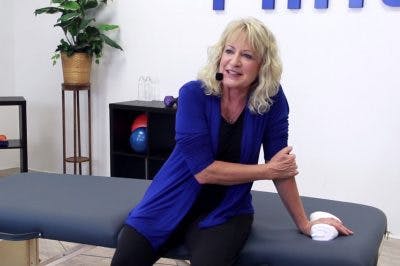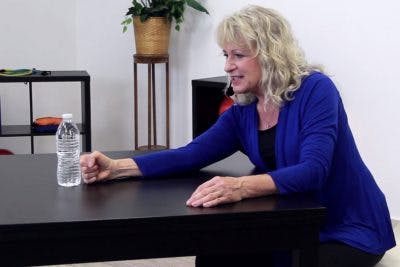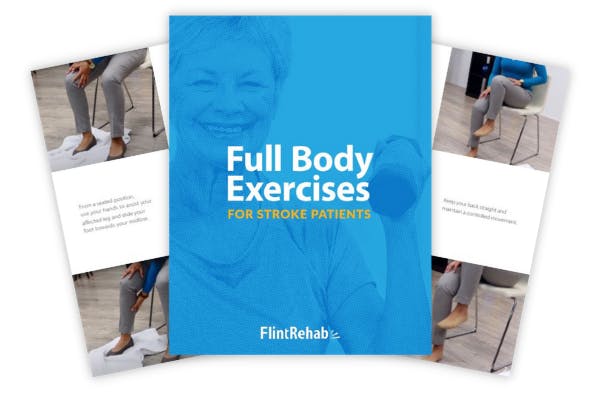Shoulder Exercises for Stroke Patients from an Expert Occupational Therapist

From a seated position, prop yourself up on your affected arm by placing your affected arm about a foot away from your body. Then lean into it.
If it feels good, stay there and feel the stretch for 10 seconds or so. And if it hurts, stop the stretch immediately.
After 10 seconds or so, place your other arm out beside you so that you’re supported by both arms. Then rock from side to side, shifting your weight from one arm to the next.
You can place a rolled towel underneath your hand to increase comfort.
2. Shoulder Tabletop Punching Movement
You will need: A tabletop and water bottle.

Place a water bottle arms distance in front of you.
Then, make a fist with your affected hand and glide your forearm across the table to “punch” (or tap) the water bottle. Keep your elbow and forearm on the table.
Try your best to avoid letting your affected shoulder lift up toward your ear.
Placing a hand on your affected shoulder or using a mirror to watch your form may help you to keep your shoulder from hiking up. If you can’t help but lift your affected shoulder, that’s okay. Putting in the effort to try is still helping your brain relearn how to use those muscles.
If your hand seems to get stuck to the table, you can try placing a towel underneath it to help it slide more easily.
3. Shoulder Pushing Movement
You will need: A tabletop and water bottle.
You will need: a cane and a chair.

Place the water bottle at arms distance and then hook the outside of your affected wrist around the bottle and push it across the table as far as you can.
Once you’ve pushed the bottle as far as you can to one side, reverse. Hook the bottle from the inside of your affected wrist and push it across the table.
Again, try your best to keep your shoulder down and your forearm and elbow on the table.
4. Cane Slide Movement
You will need: A cane and a chair.

Hold your cane at both ends and raise it up in front of you so that your arms are parallel to the floor. With the cane out in front of your body, twist your torso to the left and right.
Slowly repeat this twist back and forth and follow your arms with your eyes. As you continue to stretch, you’ll feel yourself go deeper and deeper into this twist.
Repeat 10 times, or more if it feels beneficial.
If you have difficulties with your seated balance, be sure to complete this in a chair with arms or with someone else nearby.
5. Lateral and Circular Cane Stretches
You will need: A cane and a chair.

From a seated position, place the cane away from you at arm’s length and place your affected hand on the handle. If you need more stability, secure your unaffected hand on top.
Now, lean forward while keeping yourself seated. Then lean back. You should feel this stretch all the way up your torso and into your shoulder.
Next, try making big circular motions with your upper body while using the cane for support. You can use your unaffected hand to guide your affected side in this big circular motion.
Repeat each exercise 10 times.
Again, if you are having trouble with your balance while sitting, consider having someone nearby to assist you as needed.
Combining E-Stim with Shoulder Exercise to Reduce Pain
When you practice these stroke recovery exercises, aim for at least 10 repetitions each. Repetition is key to rewiring the brain.
If you suffer from shoulder pain due to shoulder subluxation, frozen shoulder, or spasticity, then talk to your OT or PT about adding electrical stimulation to the mix.
Electrical stimulation helps the muscles contract and the upper arm to go back into the socket.
It won’t happen all at once, but combining electrical stimulation with therapy exercise is shown to produce better results.
And there you have it! We hope these shoulder exercises for stroke patients help improve your mobility and reduce your pain.
Keep it Going: Get a Free Rehab Exercise Ebook (25 page PDF)

Get our free ebook filled with 25 pages of rehab exercises featuring photos of licensed therapists. Sign up below to get your copy!
When you sign up, you’ll also receive our popular Monday newsletter that contains 5 articles on stroke recovery.
We never sell your email address, and we never spam. That we promise.
